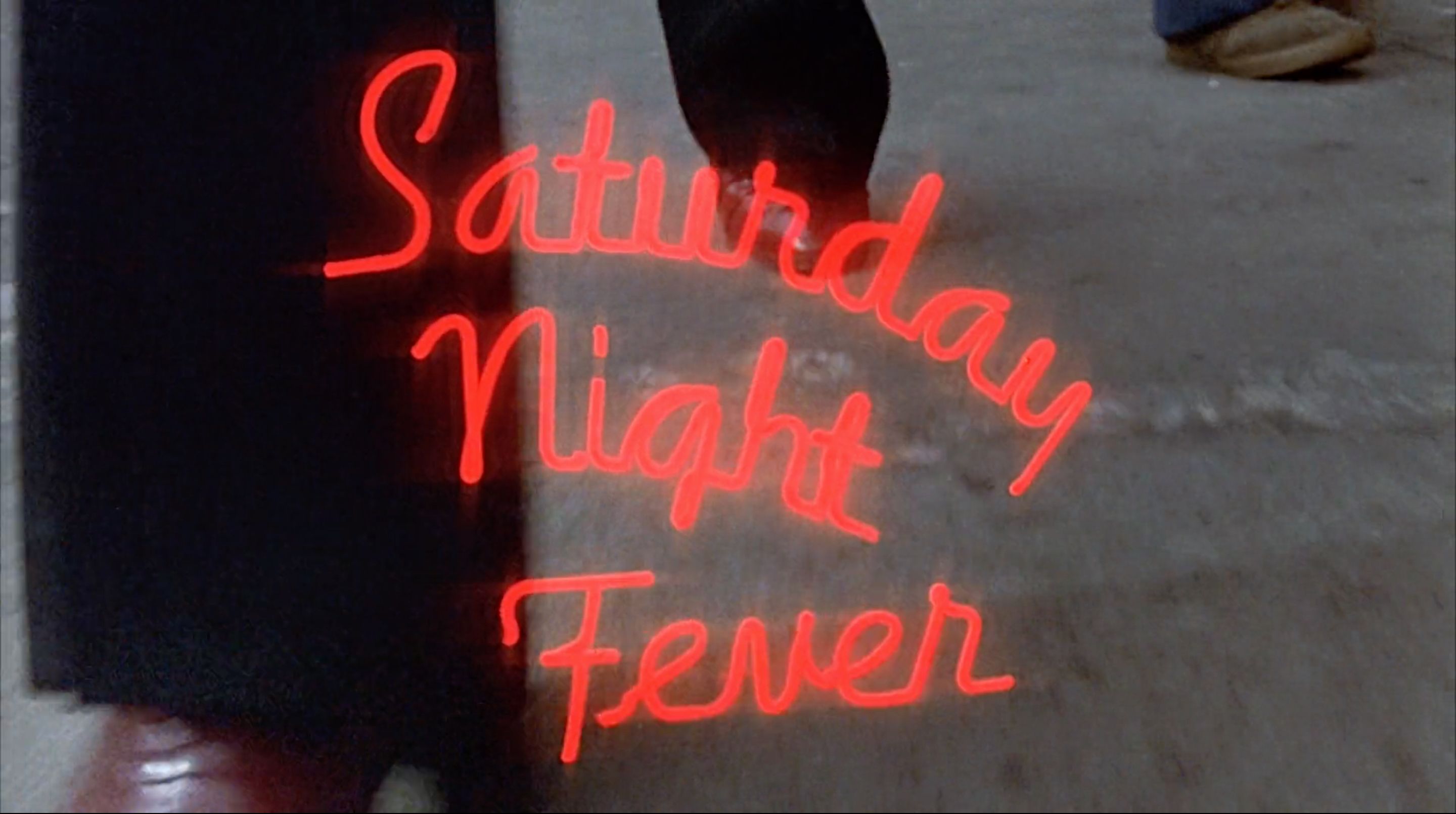 This one gets thoroughly spoiled, and also TW: rape. Read with care. Thanks!
This one gets thoroughly spoiled, and also TW: rape. Read with care. Thanks!
What is it? Saturday Night Fever, directed by John Badham, written by Norman Wexler (based on the New York magazine article “Tribal Rites of the New Saturday Night” by Nik Cohn), and starring John Travolta, Karen Lynn Gorney, Donna Pescow, Barry Miller, Joseph Cali, Paul Pape and Val Bisoglio.
First viewing? Yes, believe it or not, although I remember catching swaths of it on HBO back in the late seventies or early eighties. I definitely remember the two Verrazano-Narrows Bridge scenes.
What’s it about? Tony Manero (John Travolta), 19 years old, is a Brooklyn paint store employee by day and a superstar on the club dance floor by night. He wants to win the big dance contest with Stephanie (Karen Lynn Gorney) and maybe escape with her to Manhattan. But will his family and friends let him?
What are your thoughts about it? I don’t know, what do you think of when you think about Saturday Night Fever? I can’t read your mind, but I’m willing to bet I get some of it right. First, you almost certainly picture John Travolta, in that iconic white suit, one finger pointed to the sky, the opposite hip thrusted to one side, a unnatural, ridiculous pose that invites accusations of camp, of kitsch. Then you might flash on that equally iconic soundtack cover, with the Bee Gees hovering over John Travolta, seemingly trapped inside of some kind of monolith, like the General Zod and his flunkies floating through space in the Phantom Zone. If you do that, almost inevitably you will hear one of the band’s many hits from the album echoing in your head. You probably hear “Stayin’ Alive,” but maybe it’s “Night Fever” or “Jive Talkin’.”1 Or maybe you’re an odd duck, and you hear a non-Bee Gees hit, like “If I Can’t Have You” or “A Fifth of Beethoven.” But soon after that, you possibly think of disco balls, glowing dancefloors, gold chains, chest hair, the Beastie Boys’ “Hey Ladies” video, of camp, of kitsch.
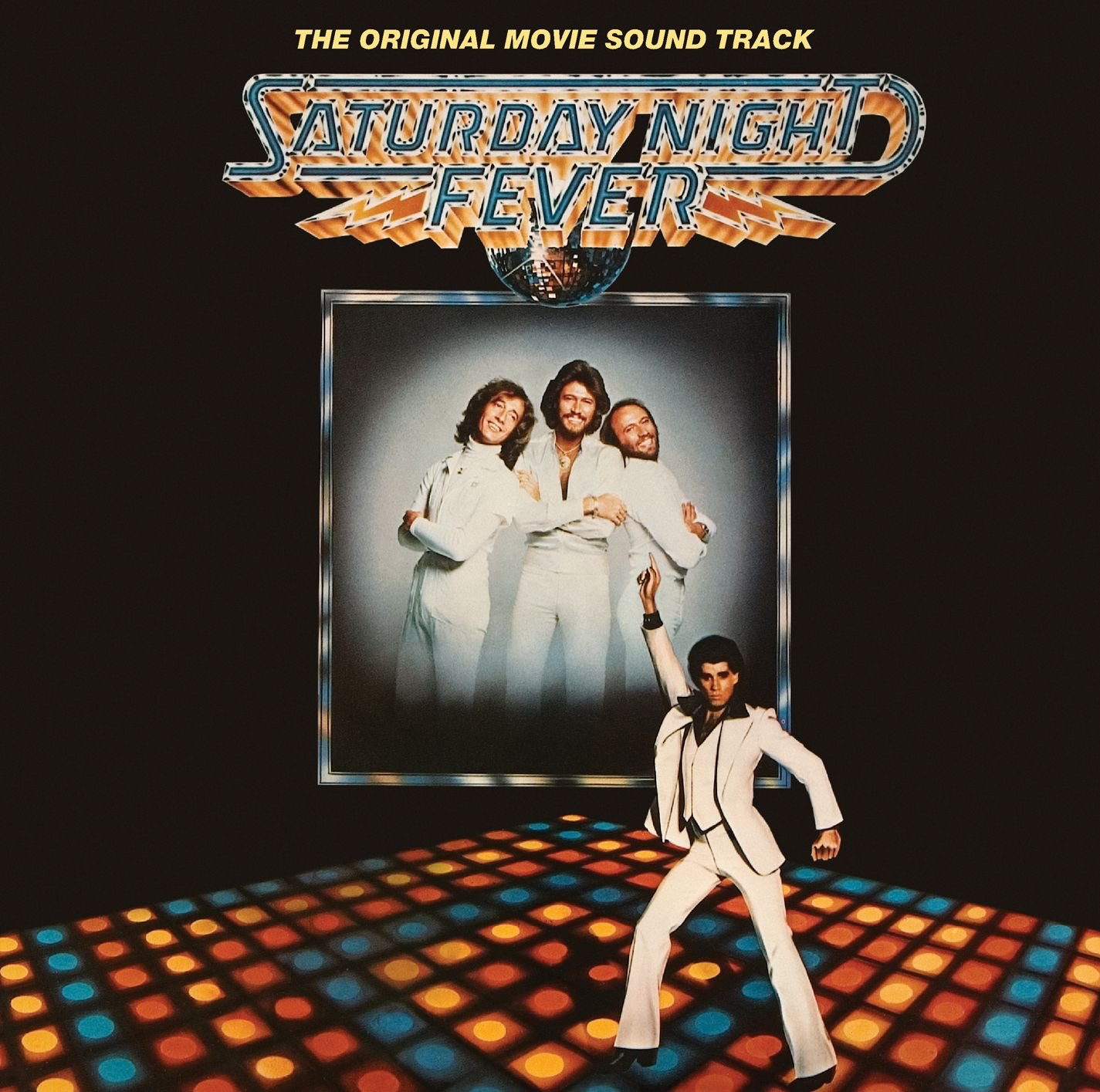 Kneel before Gibb!
Kneel before Gibb!
If that’s what you thought, no judgment here. That, of course, was my own train of thought. But, as I discovered to my own embarrassment, this is a complete misrepresentation of the film. Saturday Night Fever is a surprisingly gritty (and by the end, dark) coming of age story that just so happens to have amazing, culture-changing dance sequences. It’s more adult than what passes for adult entertainment these days, and we’ve decided (and this includes me) to drop all that down the memory hole for the fun stuff.
Let’s be clear: the fun stuff is fun. I don’t know how anyone can watch these dynamic dance sequences and not consciously or unconsciously move their body. Of course Tony spends all his dough on these weekends — it’s presented as a kind of communal heaven. I have no idea what people younger than me think of Travolta these days, but he was a major discovery. Ridiculously handsome and charismatic, yes, but the way he blurred the line between dancing and simply moving — the movie couldn’t work without him. (Travolta’s dancing in the career-reviving Pulp Fiction is extremely minimal compared to what he does here, but it just underlines that it’s not his skill, which is tremendous, but something deeper, a way of being.) He’s absolutely electric on the dancefloor — Travolta needs to convince an audience that Manero is not only good at what he does, but that dancing could conceivably be a ticket out of Brooklyn. One could argue he overshoots this goal by an order of magnitude.
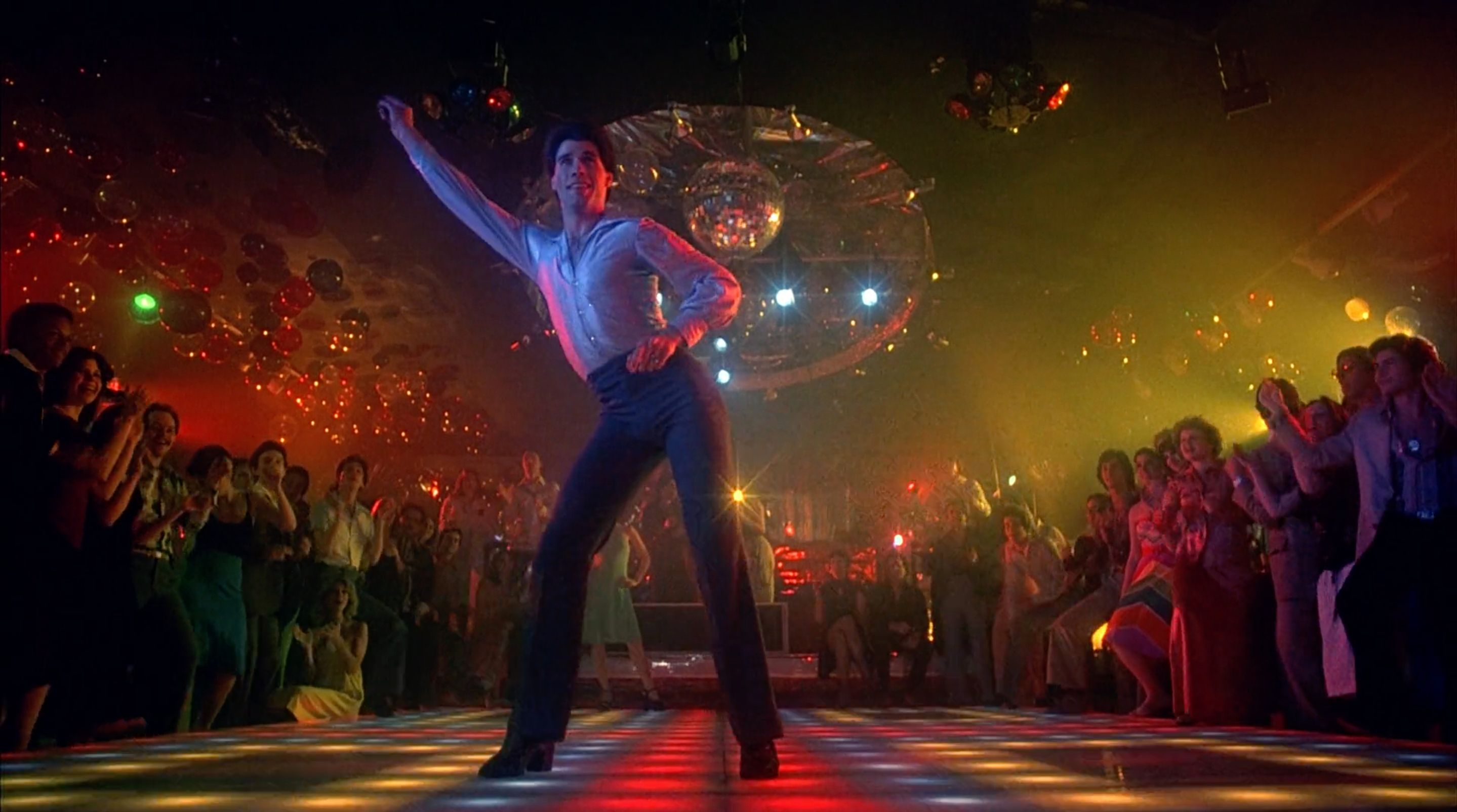 No irony, One Perfect Shot.
No irony, One Perfect Shot.
If this all that Saturday Night Fever was, if the surrounding dramatic material were inept and/or inert, then it would still likely have left a crater in pop culture. But, thankfully, the material sings, and would be compelling even without the disco stuff. Tony is only 19, but as we follow him and witness his environment, it becomes clear that, despite his young age, his options are disappearing. His job at the paint store is a dead end. His family is barely supportive of his actual job, so the idea that they might support any dreams of being a dancer is a non-starter. His friends are, generally, awful. It appears that the only girl he knows or talks to is Annette2, and it’s clear to Tony that she just wants to be, as he says, “a married sister.” The sama drama is playing out in front of him with his friend Bobby C., who’s being pressured by his family and church to marry the girl he impregnated. For Tony, the nightmare of Invasion of the Body Snatchers has come two years early, only it’s not aliens, it’s the environment he’s living in.
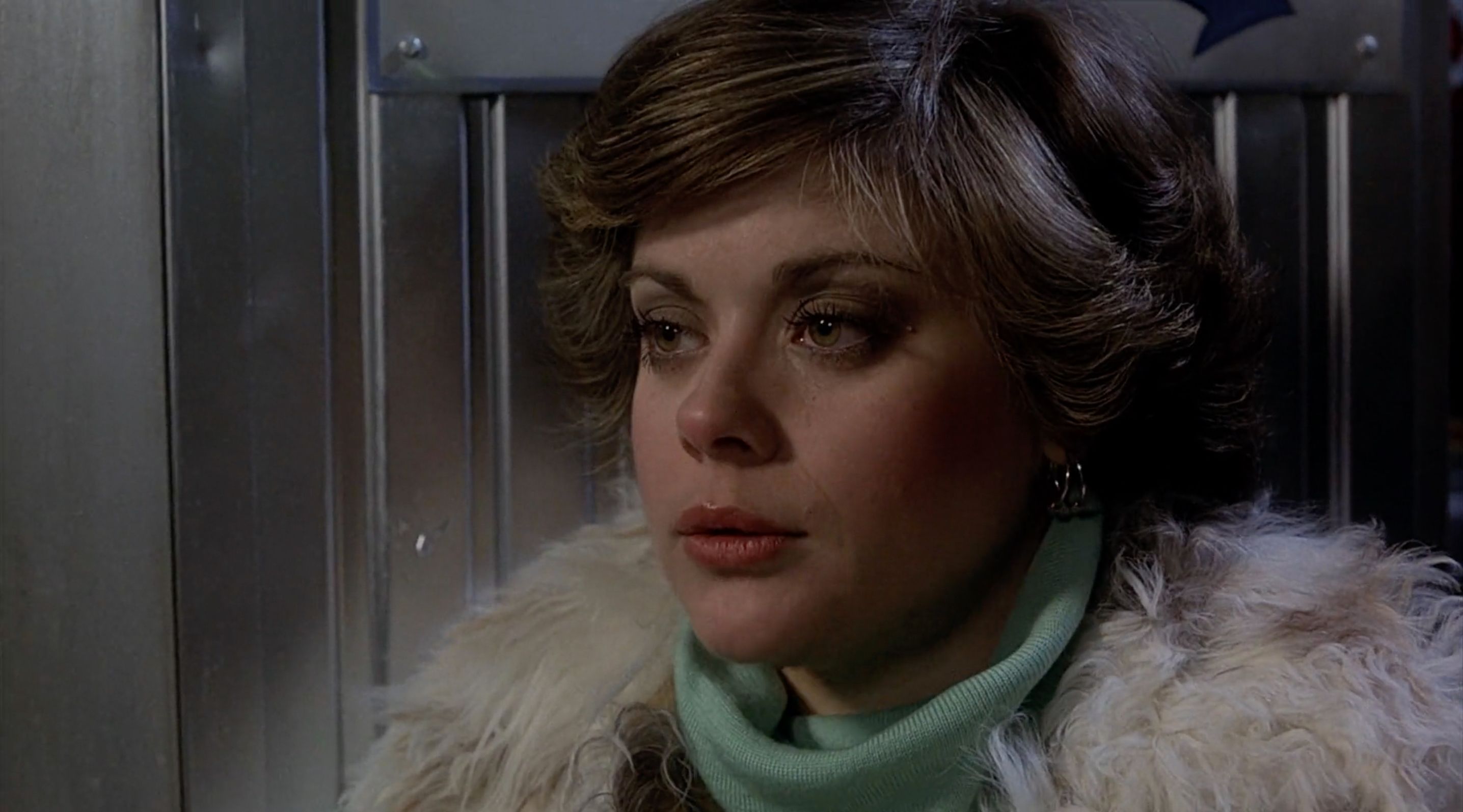 Donna Pescow is generally underrated and she’s great in this.
Donna Pescow is generally underrated and she’s great in this.
It almost gets him, too. Tony isn’t some pure knight of virtue who brushes off the temptations of the world or fights against the injustices meted out by society. He’s just in the muck as everyone else, just as confused, just as capable of making terrible decisions, just as subject to the unthinking prejudices of his culture. He’s racist, misogynistic, and possibly homophobic3. “You gotta decide if you’re a nice girl or a cunt,” he tells Annette, placing her into a binary that he wouldn’t accept for himself, making him a hypocrite as well. Tony is cruel to Annette, but it’s his unthinking reaction to something he knows instinctively, that she’s in the opposite direction of where he’s trying to go. It’s a credit to screenwriter Norman Wexler that not only is Tony’s choice — generally “good,” him trying to escape suffocating circumstances — presented in an awful way, but that it also has terrible consequences later on.
 Not Manhattan (Not 1979, Not Woody Allen)
Not Manhattan (Not 1979, Not Woody Allen)
Tony’s only escape is to somehow get to Manhattan. He could stroll over the Brooklyn Bridge any time, of course, but the problem isn’t physical. Tony and his friends make a habit of stopping on the Verrazano-Narrows Bridge and goofing off, treating the dangerous structure like a jungle gym. No, Tony can cross bridges all he wants — but it’s telling that the one he’s on most often goes in the opposite direction he needs to go. This bridge has also claimed one victim in the past, and will claim another by film’s end.
It’s not surprising, then, that Tony is attracted to Stephanie. She’s pretty, yes, and she’s a great dancer, yes, but more importantly, she’s originally from his side of the bridge and now lives on the other side. Tony thinks he wants her; Tony wants to be her4. He wants what she has. It won’t be easy, though. As they have coffee, it’s apparent they almost literally don’t speak the same language. At the same time, though, they kinda don’t have to — they say what they need to say with their bodies on the dance floor.
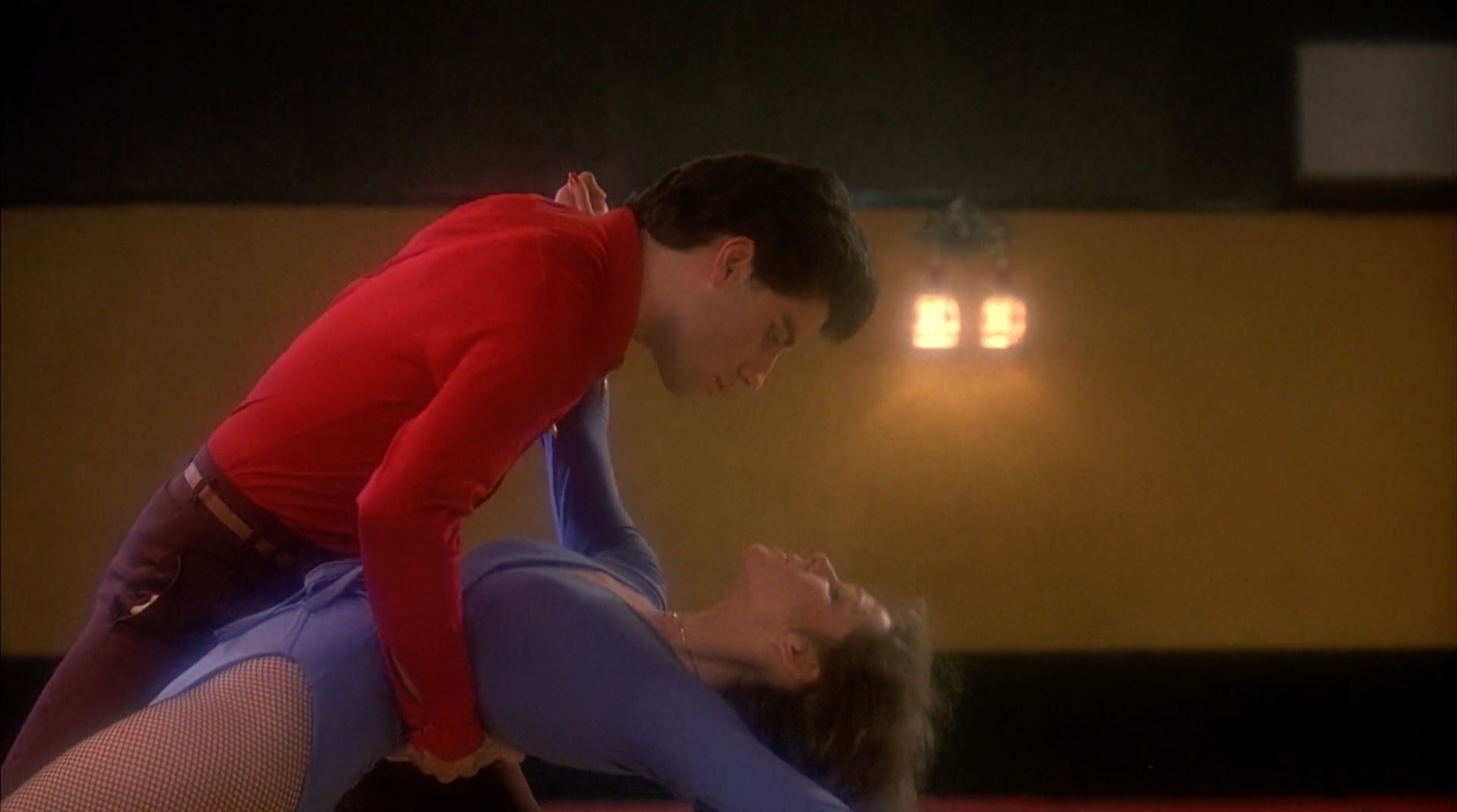 Tony and Stephanie practice to the tune of “More Than a Woman.” A friend of mine told me that, as as kid, he thought the words were “bald-headed woman.” I can only hear it that way now. Thanks, Scott. This anecdote will return if I ever get around to STAR TREK: THE MOTION PICTURE (1979, Robert Wise).
Tony and Stephanie practice to the tune of “More Than a Woman.” A friend of mine told me that, as as kid, he thought the words were “bald-headed woman.” I can only hear it that way now. Thanks, Scott. This anecdote will return if I ever get around to STAR TREK: THE MOTION PICTURE (1979, Robert Wise).
The film isn’t sweetness and light by any means, but in the last fifteen minutes, the depths of darkness it’s willing to go to can be surprising for the unprepared. Tony and Stephanie have been practicing their big dance routine for the contest with the cash prize of $500 ($2500 in 2021 money). Although it’s never directly said, it’s implied that this money can get Tony straight out of Brooklyn. They perform. And when I watched it for the first time, I was confused. Their routine is weak sauce, compared to their previous performances and especially compared to the two competing teams we see. It looked like the film was clearing the path for a completely false, unearned feel-good ending5.
 A fraudulent version of SATURDAY NIGHT FEVER ends around here.
A fraudulent version of SATURDAY NIGHT FEVER ends around here.
I needn’t have worried. Tony states outright that their performance was crap, that he and Stephanie don’t deserve to win, and then they do win. Tony realizes the fix is in; even if Tony and Stephanie just stood there and farted, there was no way the judges were going to pick the Black or Latinx couple over him. Tony, in a move that genuinely stunned me, gives the prize money to the 2nd place Latinx team. He isn’t magically absolved of his racism, but he gets a glimpse of his white privilege, and it disgusts him.
If the film ended on that emotional reversal, where winning is losing and vice-versa, that might’ve been enough. But the filmmakers aren’t done with us. Tony, having just acted in accordance with his better angels, immediately flips to his worse demons. Stephanie, upset that Tony has given away her half of the money, lashes out at him. This leads to a moment that, I think understandably, loses a lot of people: Tony attempts to rape Stephanie.
Tony’s world has shattered. The one thing he felt made him special, the thing he was hoping would carry him over the bridge, is revealed as a sham. (It isn’t of course; he really is that good. There’s just no way he can see that at the moment.) So Tony gives up. If he’s no different than his thuggish friends, then the pods may as well take him. In a single action, he could destroy her and himself, and I think that’s exactly what he wants.
It’s an ugly, ugly scene, one that fortunately doesn’t last long — she knees him in the nuts. Tony’s sanity and composure is restored, like when a character slaps a mind-controlled friend back into normalcy. But we still have one more gut punch coming. This entire time, Tony has been making decisions that were about keeping him focused on his goal of getting across the bridge. Again, these are “good” decisions, but they come at a cost. Perversely (because this is a great script), Tony isn’t the one to pay. Tony’s decisions to, essentially, ignore Annette and Bobby C. end with her being raped by Joey and Double J., and Bobby C. falling to his death.
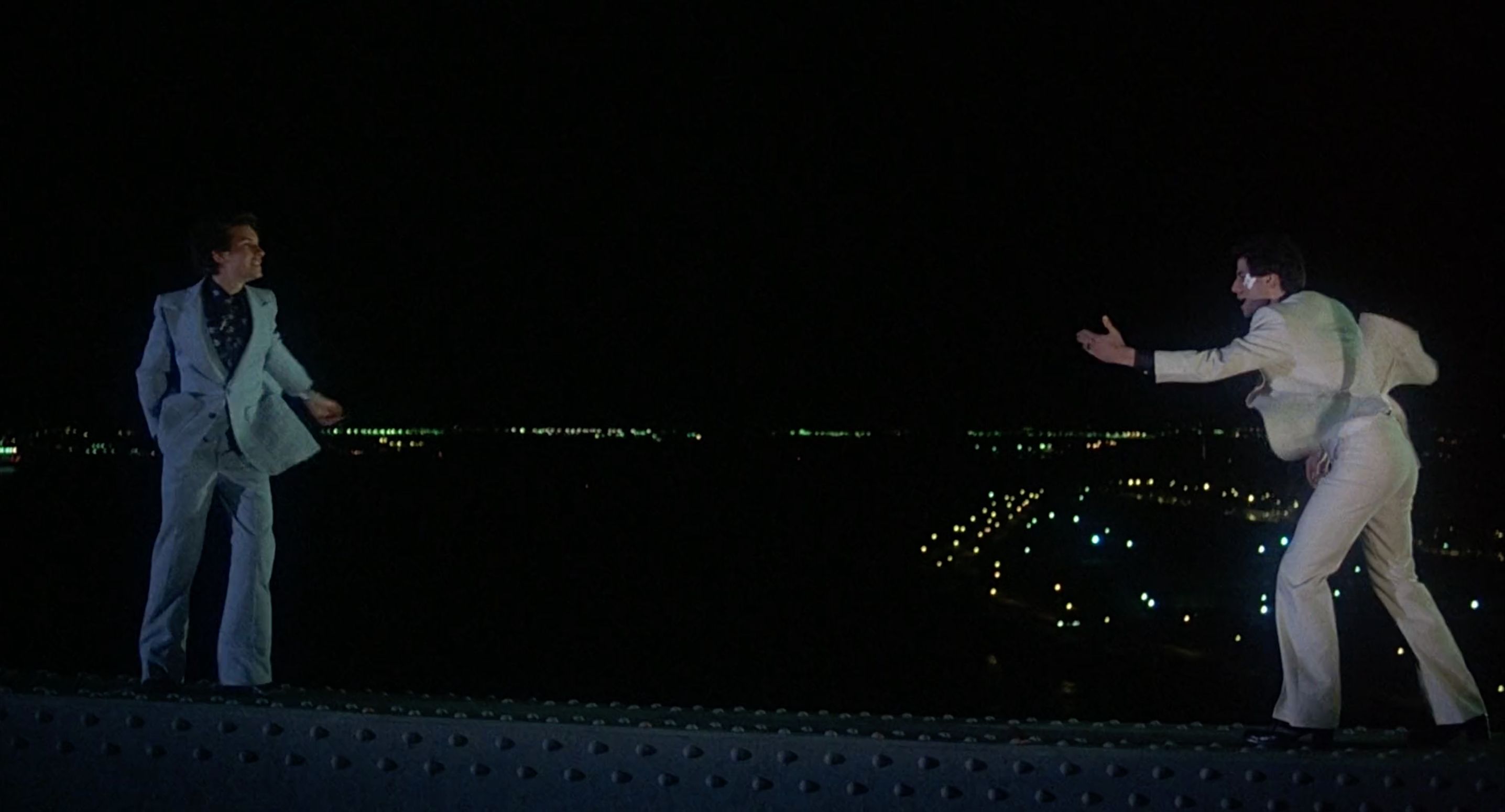 I presume this was shot on a soundstage, and if so, it’s extremely convincing in the moment. Big ups to cinematographer Ralf D. Bode for keeping the lighting the same across the whole sequence, which does involve location shots. (This may be the first time anyone’s ever complimented the special effects in SATURDAY NIGHT FEVER.)
I presume this was shot on a soundstage, and if so, it’s extremely convincing in the moment. Big ups to cinematographer Ralf D. Bode for keeping the lighting the same across the whole sequence, which does involve location shots. (This may be the first time anyone’s ever complimented the special effects in SATURDAY NIGHT FEVER.)
Faced with the ugly reality of his friends, his guilt over Annette, and the death of his friend (in a sense, witnessing his own death), Tony is finally able to break ties with these people and this city. He doesn’t take the bridge, though. (How could he?) He goes underground, via the subway, practically slinking away. There is nothing for him in Brooklyn, but he may have fucked up his only chance at something in Manhattan.
He goes to Stephanie, apologizes, tells her that he wants to move into the city. Doing so, Tony crosses a completely different kind of bridge, one that he didn’t even realize was there. He now sees that there’s a third way, that he can relate to a woman in a way other than “mother” and “whore” that has defined his reality up until this point. He can be a friend 6.
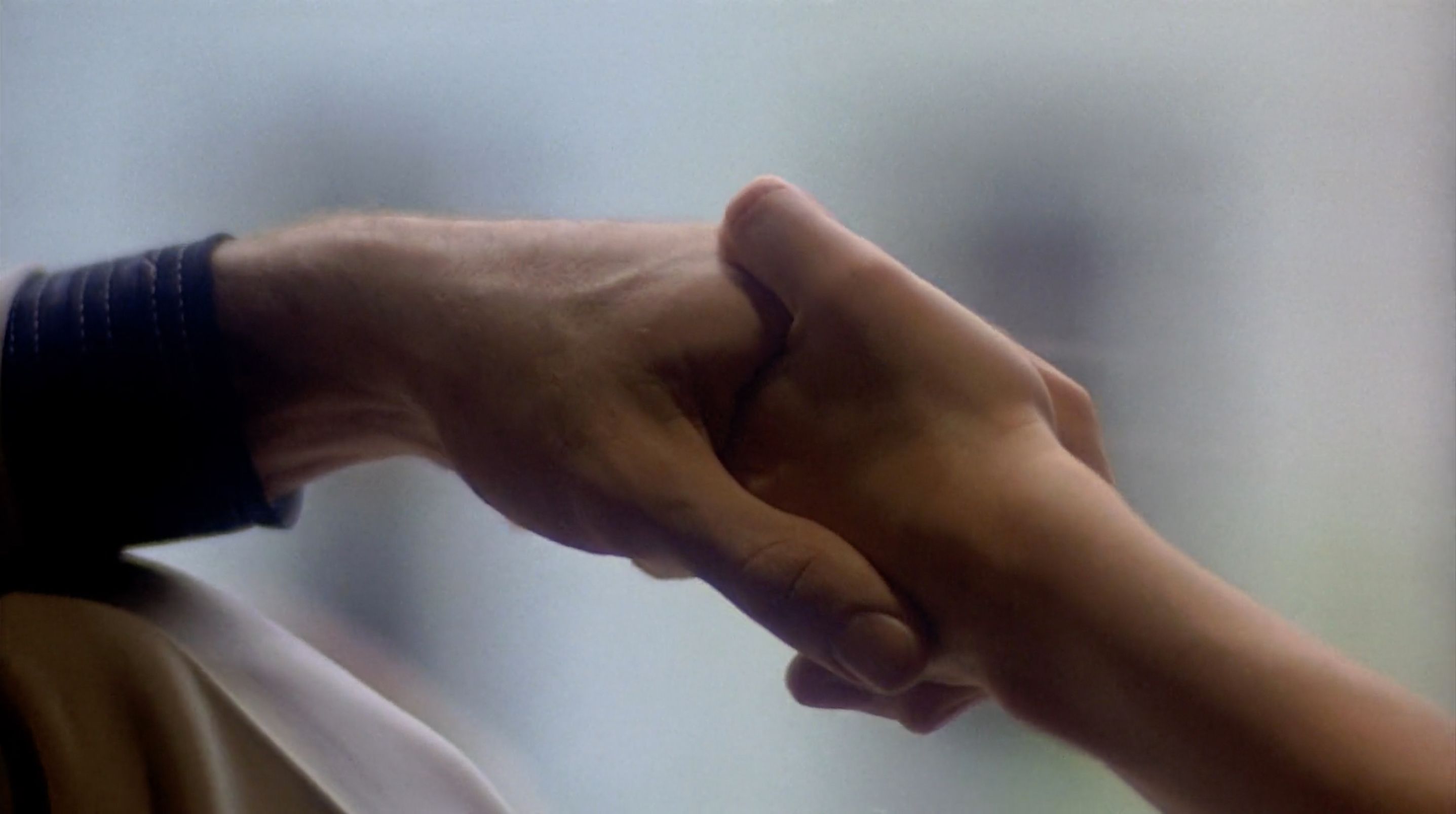 Not Toy Story 3 (Not 2010, Not Lee Unkrich)
Not Toy Story 3 (Not 2010, Not Lee Unkrich)
Where can I stream it? As of this writing7, you can watch it for free on HBO Max, HBO Max Go, DirecTV, Cinemax via Amazon Prime and Spectrum, or rent or buy it from Amazon, Apple, Google Play, Microsoft Store, YouTube, Vudu, Redbox, AMC Theaters On Demand, and DirecTV.
What can we take from it? So I just spent something like 1500 words to say that Saturday Night Fever is a complex, subtle, dark and gritty drama that just happens to have some amazing dance sequences, and isn’t the kitschy time capsule some think it is.
And now I’m going to throw all that away in the name of roleplaying games.
I’m not saying serious themes don’t belong in rpgs. Depending on the players and GM, they absolutely have a place at the table. However, at heart, Against the ’70s is not a serious game. The key concept is incongruity, and incongruity generally, not always but generally, leads to humor and silliness. I hope taking the big, obvious, fun stuff from Saturday Night Fever isn’t considered a betrayal of the movie. The dance floor was an escape for Tony Manero; an imaginary one can be an escape for us.
I’m writing something special based on Saturday Night Fever, but more info on that at a later time8. Right now, I offer something lighthearted and goofy for the Cypher System: Tony Manero as an NPC, a special set of shoes as a cypher, and a very recognizable article of clothing as an artifact.
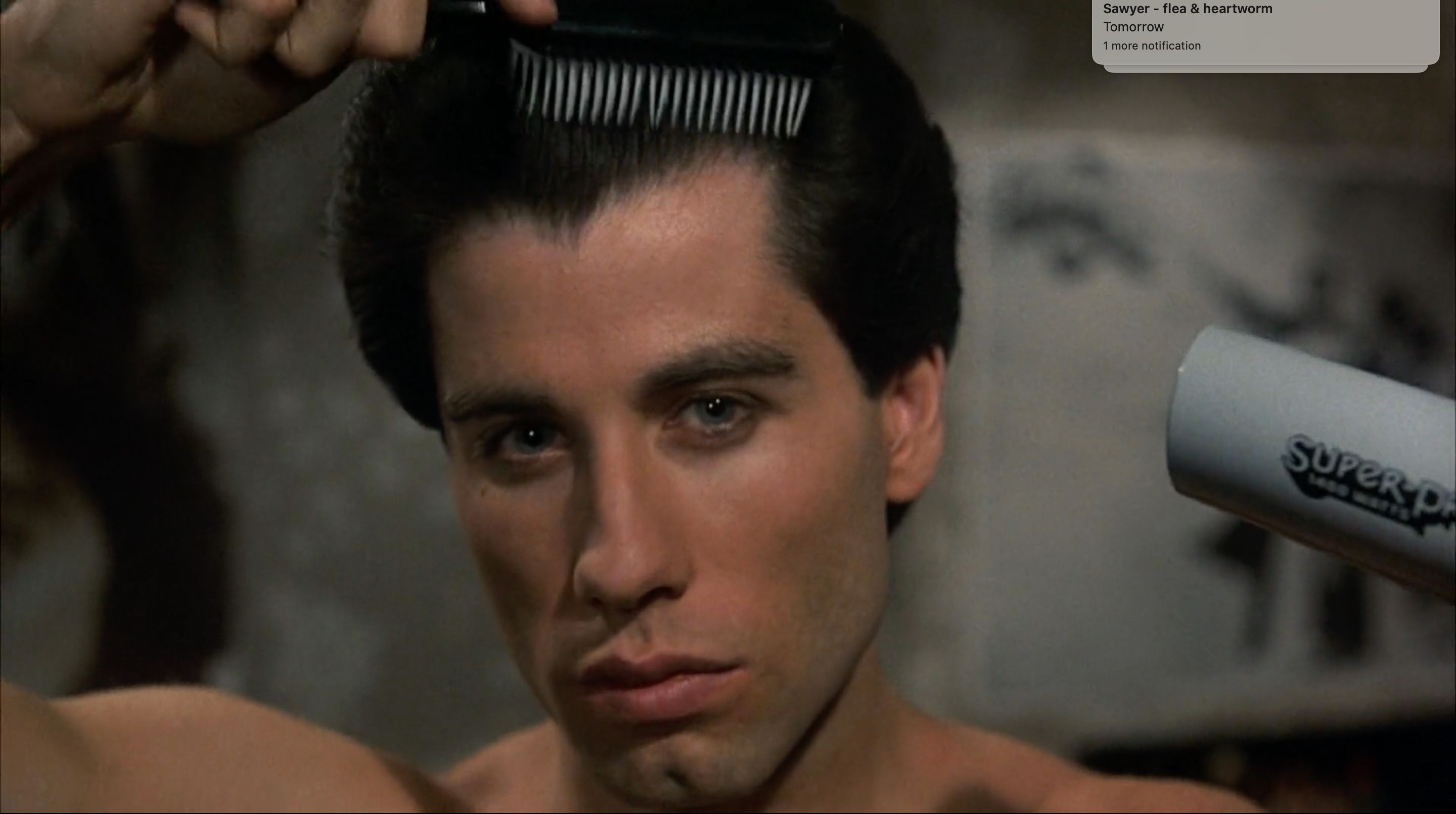 ANTHONY “TONY” MANERO
ANTHONY “TONY” MANERO
Level: 3 (9+ on a d20 to hit, 9+ on a d20 to avoid being hit)
Description: An absurdly handsome and charismatic Italian-American nineteen year old with perfect hair.
Motive: To metaphorically and actually cross the bridge into Manhattan.
Health: 9
Damage Inflicted: 1
Movement: Short
Modifications: All dancing tasks are eased by two steps, and all knowledge tasks relating to the Verrazano-Narrows Bridge are eased by two steps. Also, doing the two-step is eased by two steps. No wait, that’s Urban Cowboy (1980, James Bridges) and beyond the scope of this article.
Combat: Tony is more than willing to throw down to help out friends. He’s a dancer, not a fighter, however, and only inflicts 1 point of damage.
Interaction: Tony is a gregarious and helpful guy, if also a little dim and egotistical. Everything in his life revolves around Saturday nights at the 2001 Odyssey, so the further away the topic is from that, the less Tony is interested.
Use: Tony comes to the PCs because he’s seen a ghost on the Verrazano-Narrows Bridge; Tony comes to the PCs because his brother, a priest, has been acting strange after performing an exorcism on a little girl.
Loot: Tony doesn’t carry any cyphers or artifacts on him. However, back in his bedroom, he has a clerical collar that can be used as a manifest cypher (when worn, can convince every NPC in a single encounter that you are a person of the cloth).
GM Intrusion: Tony wins the dance contest even though his performance was more personally fulfilling than good.
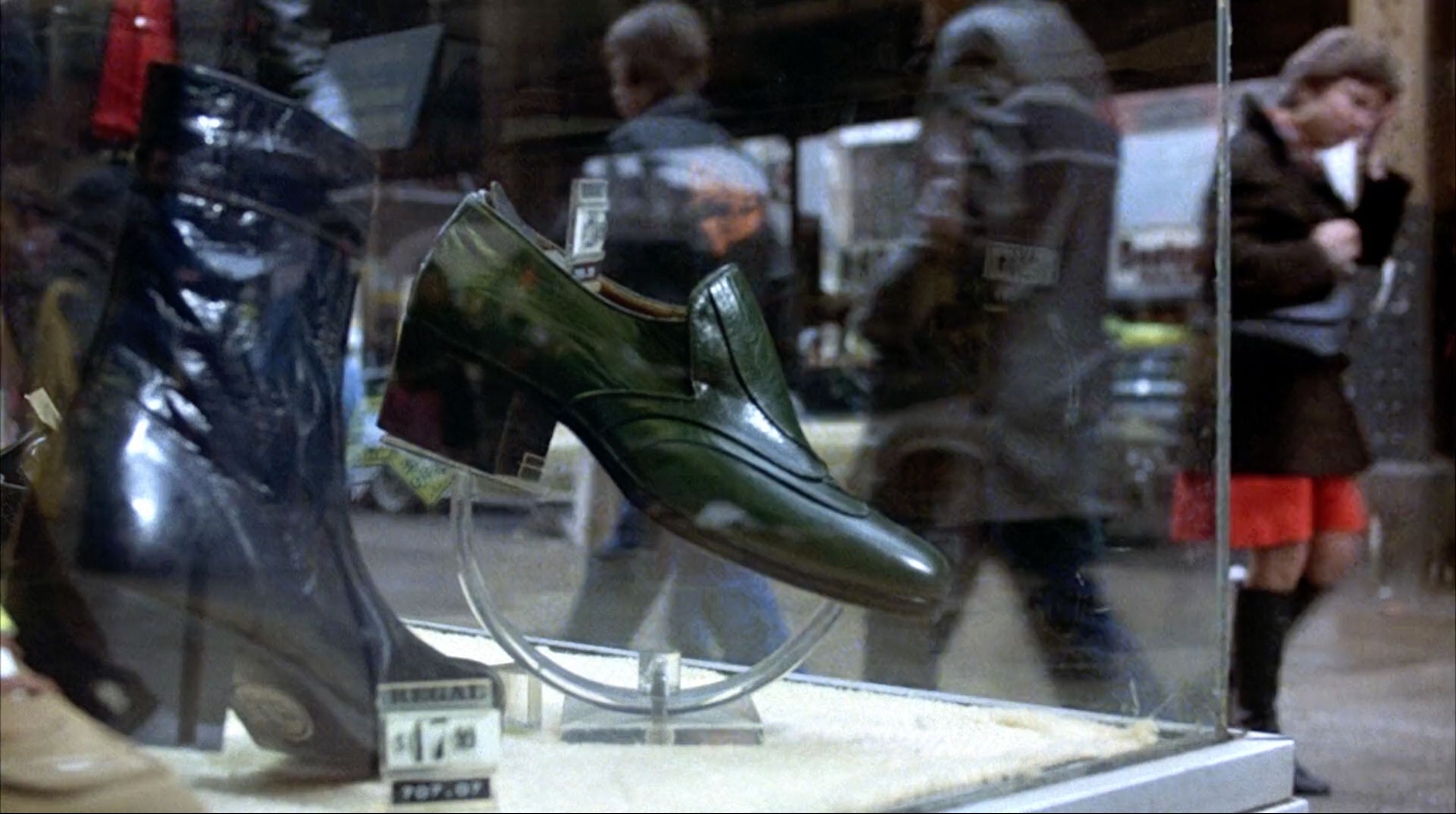 BOOGIE SHOES (CYPHER - MANIFEST)
BOOGIE SHOES (CYPHER - MANIFEST)
Level: 1d6
Effect: When these high-heeled dance shoes are worn, all Speed tasks for a number of rounds equal to the level are eased by one step, including defense tasks.
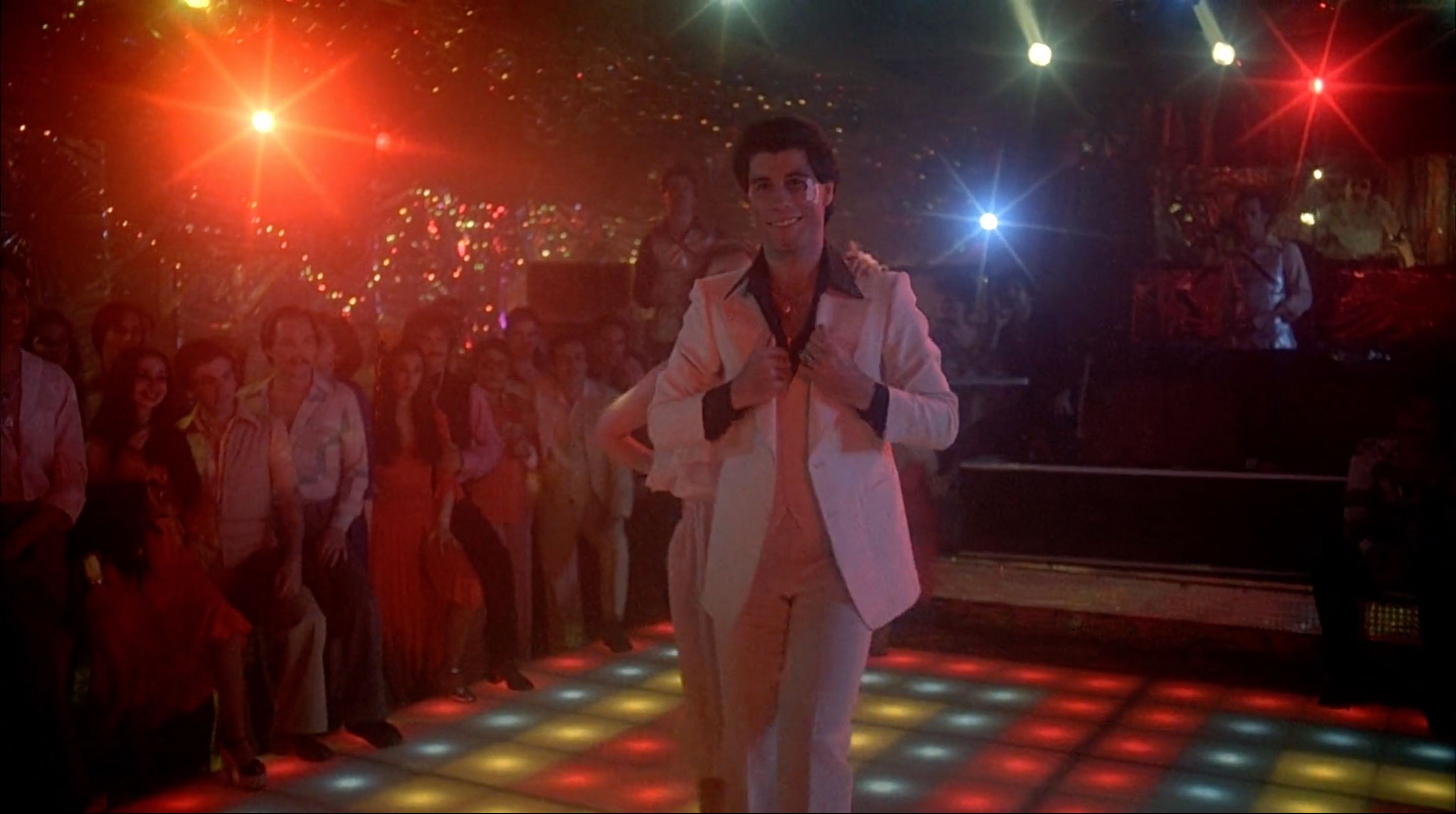 POLYESTER DISCO SUIT (ARTIFACT)
POLYESTER DISCO SUIT (ARTIFACT)
Level: 1d6+4
Form: A three-piece ivory polyester suit (jacket, vest, pants) and a black wide-lapel shirt.
Effect: When the Disco Suit is worn while dancing, everyone watching reacts positively to the wearer. Any NPCs, regardless of their attitude prior to the dance — even if they are out to kill the wearer — will stop and admire the wearer. This attitude change disappears after a few rounds once the dance has ended, so the wearer has a short amount of time to interact with NPCs; the wearer is granted an asset for persuasion tasks. Whether or not a player character can just start dancing in the middle of an encounter, regardless of context, is left to the GM. If your game allows this kind of silliness, disco music begins to play while the wearer dances.
Depletion: Polyester is not a breathable fabric, so the suit has a 1 in 6 chance of being destroyed from sweat.
Note: For an interesting and detailed look at Saturday Night Fever’s iconic white suit, check out this article at BAMF Style.
Next time on Against the ’70s: Gone in 60 Seconds (1974, H.B. Halicki)
Originally published 2/3/22 on Substack.
Technically, “Jive Talkin’” was from a previous Bee Gees release, and although it was used in the film, the scene was cut. But that doesn’t sound right, does it? Like, of course it’s a Saturday Night Fever song. That’s some real Mandela Effect shit.↩︎
If, by the end, it seems that the film doesn’t care about Annette, it’s only because this story isn’t hers. That said, it’s clear that she’s going through the same thing as Tony, just from a woman’s perspective. Sometimes, Saturday Night Fever seems like the new world the young girls get deposited into at the end of Lucile Hadžihalilović’s Innocence (2004), lambs completely unprepared for a city of wolves.↩︎
When his buddies harass the gay couple, Tony hangs back and doesn’t say anything. I haven’t bothered to check, but I assume there’s at least one reading of Saturday Night Fever as a man coming to terms with being gay. That’s not my reading here, but the evidence is there if you look for it.↩︎
And now I’m thinking how Stephanie is similar, metaphorically, to Trinity in The Matrix. But I’ll leave that to smarter, transer critics than I. Also, if you’ve never read it, here’s an amazing breakdown of The Matrix as trans narrative by Tilly Bridges. Note: connects to the service formerly known as Twitter.↩︎
At the same time, their performance at the contest is the culmination of their short-term partnership, all that tension and conflict and back-and-forth ending in a passionate kiss. The dance wasn’t for the judges; it was for them. This screenplay is so good!↩︎
See footnotes #3 and #4.↩︎
2/3/22↩︎
I’m actually still working on that! Probably won’t see it for at least a year, though.↩︎